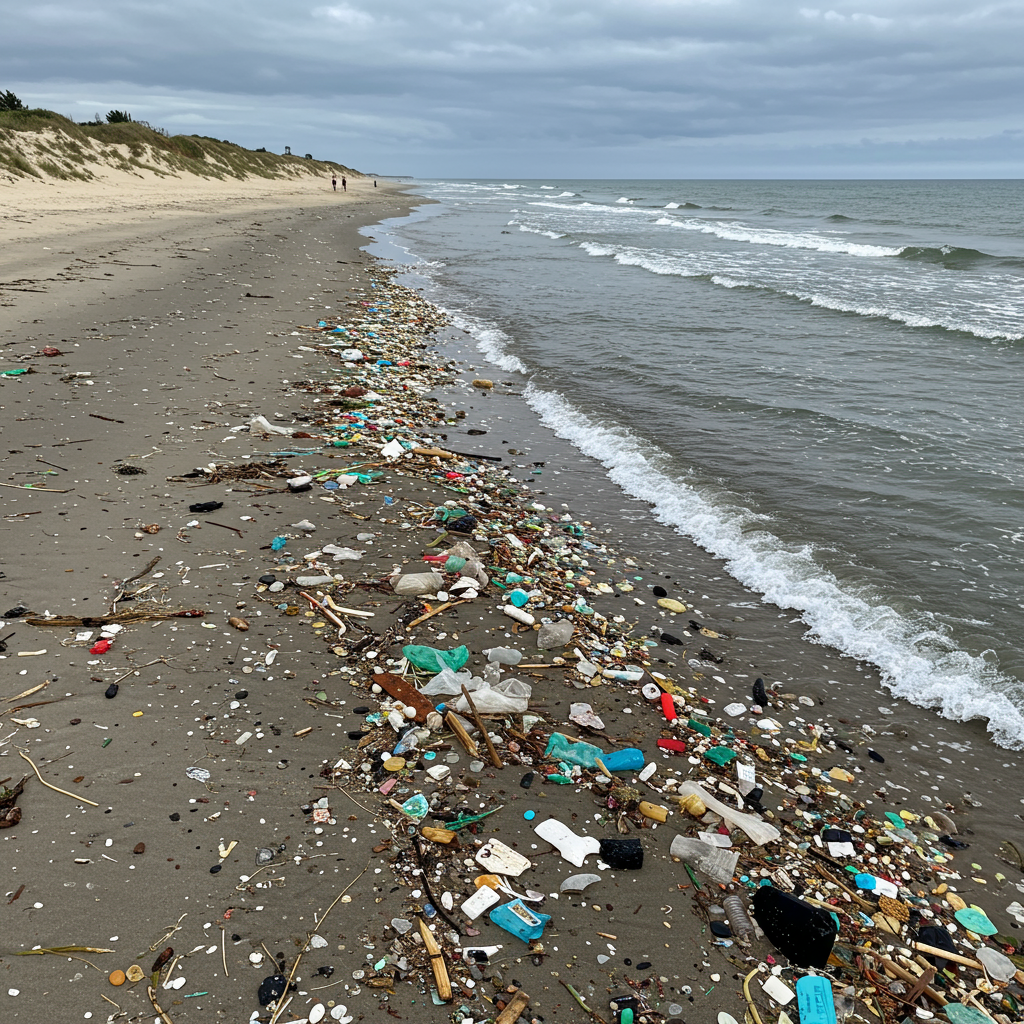A significant new study suggests that living near coastal waters heavily polluted with microplastics along the U.S. shoreline may significantly increase the risk of serious cardiometabolic conditions, including Type 2 diabetes, stroke, and coronary artery disease. These conditions are known to contribute to reduced life expectancy.
The research, published in the Journal of the American Heart Association, is one of the first large-scale studies to examine the potential link between environmental microplastic pollution levels in coastal waters and chronic health conditions among nearby residents.
What the Study Found
Researchers analyzed data from 152 U.S. coastal counties across the Pacific, Atlantic, and Gulf Coasts. They looked at mean marine microplastic levels (MML) in ocean waters within 200 nautical miles of these counties between 2015 and 2020. Coastal areas were categorized based on pollution levels, from low to very high, with “very high” areas containing 10 or more plastic particles per cubic meter of ocean water.
This pollution data was then compared against the prevalence rates of Type 2 diabetes, coronary artery disease (where plaque blocks heart blood vessels), and stroke among residents in these same counties, using health data from the CDC for the same period. The analysis adjusted for various factors that could also influence health outcomes, such as age, sex, race, ethnicity, access to physicians, and socioeconomic status.
The findings revealed a clear association:
Compared to residents living near low pollution waters (defined as minimal plastic specks), those in counties adjacent to very high microplastic pollution areas showed an 18% higher prevalence of Type 2 diabetes.
These residents also had a 9% higher risk of stroke.
Additionally, they faced a 7% higher risk of coronary artery disease.
Geographically, counties along the Gulf of Mexico and Atlantic coasts tended to show a higher prevalence of these diseases associated with pollution levels compared to those on the Pacific coast.
Microplastics Are Everywhere
While this study focused on ocean water pollution, experts emphasize that microplastics and even smaller nanoplastics (particles measured in billionths of a meter) are pervasive. They are found not just in oceans but also in drinking water, the food we eat (especially seafood), and even the air we breathe.
These minuscule polymer fragments, ranging from less than 5 millimeters down to 1 micrometer, can potentially invade individual cells and tissues throughout the body, including in major organs like the liver, kidney, brain, and have even been found crossing the placental barrier to reach unborn children. Recent studies have detected microplastics in human brain tissue, blood, lungs, liver, testes, placenta, mother’s milk, urine, and feces.
How Might Microplastics Cause Harm?
Scientists theorize that the health risks aren’t just from the physical presence of the particles themselves but also from the chemicals they carry or leach. Plastics contain numerous additives and can absorb pollutants from their environment. These include known harmful substances like:
Bisphenols (e.g., BPA): Endocrine disruptors linked to fetal abnormalities, low birth weight, brain and behavior disorders in children, and diabetes, heart disease, cancer, and obesity in adults.
Phthalates: Found in many consumer products, linked to hormonal disruptions, inflammation, and potentially contributing to heart disease mortality.
Flame retardants
PFAS (per- and polyfluoroalkyl substances)
Heavy metals
These chemicals can potentially disrupt cellular processes, interfere with hormones, and cause inflammation, contributing to the development of chronic diseases. Areas with high concentrations of petrochemical and plastic production plants, often referred to as “Cancer Alley” along the Gulf of Mexico, already show higher rates of cancer, diabetes, and respiratory diseases, suggesting a link between chemical exposures and health outcomes.
Study Limitations and Future Research
It’s crucial to note that this study shows a strong association or correlation between living near highly polluted waters and increased disease prevalence; it does not definitively prove that the microplastics in the water caused these health conditions in the residents.
The researchers acknowledge several limitations:
It’s a county-level analysis, not a study of individual residents’ exposure or health.
Plastic levels were measured in ocean water, not within the residents’ bodies.
The exact biological mechanisms by which these particles might harm the body are not yet fully understood.
The study didn’t account for all potential sources of microplastic exposure (like diet or air quality in residents’ specific homes).
Senior author Dr. Sarju Ganatra emphasized that while the findings are compelling and highlight the potential public health dimension of plastic pollution, they should serve as a call for more in-depth research, including studies measuring individual exposure and its biological effects.
Reducing Your Exposure to Plastics
While global cleanup efforts for microplastics are challenging, individuals can take steps to reduce their personal exposure to potentially harmful plastic chemicals:
Reduce your plastic footprint: Opt for containers made of stainless steel or glass whenever possible.
Avoid heating food or drinks in plastic: This includes microwaving and putting plastic in the dishwasher, as heat can cause chemicals to leach out.
Be mindful of plastic types: Check the recycling code on the bottom of plastic packaging. Avoid plastics with recycling code 3, which commonly contain phthalates.
Cut down on single-use plastics: Use reusable bags for shopping, fabric garment bags for dry cleaning, and bring your own mug or silverware for takeout.
This study adds to growing concerns that the plastic waste entering our environment may be cycling back to affect human health, underscoring the need to address plastic pollution as both an environmental and a potential public health crisis.



